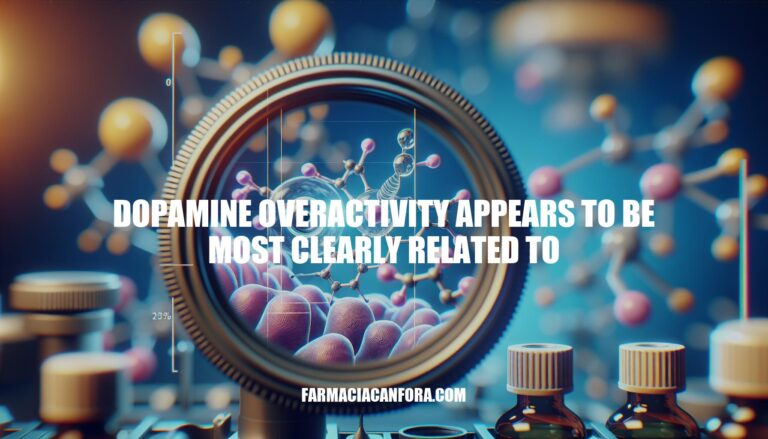


Dopamine overactivity refers to an excessive amount of dopamine, a neurotransmitter, in the brain. This imbalance is most clearly linked to specific mental health conditions such as schizophrenia, ADHD, and addiction.
Dopamine overactivity is closely linked to the positive symptoms of schizophrenia, particularly hallucinations and delusions. This connection is primarily due to the hyperactivity of dopamine in the mesolimbic pathway, a key brain region involved in reward and emotion processing.
In schizophrenia, excessive dopamine activity in this pathway can lead to an overstimulation of dopamine receptors, particularly the D2 receptors. This overstimulation is believed to cause the brain to misinterpret sensory information, leading to hallucinations (seeing or hearing things that aren’t there) and delusions (strongly held false beliefs).
The dopamine hypothesis of schizophrenia, which has been supported by various studies, suggests that drugs blocking dopamine receptors can reduce these positive symptoms, further highlighting the role of dopamine overactivity.
Dopamine overactivity is closely linked to manic episodes in bipolar disorder. During these episodes, elevated dopamine levels can lead to heightened mood, increased energy, and hyperactivity. This overactivity stimulates the brain’s reward pathways excessively, causing symptoms like euphoria, reduced need for sleep, and impulsive behavior. Essentially, the brain’s reward system becomes overactive, driving the intense emotions and actions seen in mania.
Dopamine overactivity in the brain is closely linked to ADHD symptoms, particularly impulsivity and hyperactivity. Dopamine is a neurotransmitter that plays a key role in reward, motivation, and attention. In individuals with ADHD, there is often an imbalance in dopamine levels, leading to insufficient regulation of these functions.
This imbalance can result in:
These symptoms are thought to arise because the brain’s reward system is not functioning optimally, causing individuals to seek out stimulating activities to compensate for the lack of dopamine regulation.
: Psych Central
: Mayo Clinic
: CDC
Dopamine overactivity is closely linked to the reinforcing effects of addictive substances, which can lead to substance abuse disorders. Here’s how it works:
Dopamine Release: When an individual uses an addictive substance, it triggers a significant release of dopamine in the brain’s reward system, particularly in the nucleus accumbens. This surge creates intense feelings of pleasure and euphoria.
Reinforcement: The brain associates the substance use with these pleasurable feelings, reinforcing the behavior. This reinforcement makes the individual more likely to seek out the substance again to recreate the pleasurable experience.
Tolerance and Dependence: Over time, the brain’s reward system becomes less responsive to normal levels of dopamine due to repeated exposure to the substance. This leads to tolerance, where higher doses of the substance are needed to achieve the same effect. Dependence develops as the brain relies on the substance to maintain normal dopamine levels.
Compulsion: The powerful association between the substance and pleasure creates a compulsion to use the substance, even in the face of negative consequences. This compulsion is a hallmark of addiction.
Neurobiological Changes: Chronic substance use can lead to long-lasting changes in the brain’s structure and function, further entrenching the addiction and making it difficult to quit.
These mechanisms illustrate how dopamine overactivity contributes to the cycle of addiction, reinforcing substance use and leading to substance abuse disorders.
Dopamine overactivity is linked to several mental health conditions, including schizophrenia, bipolar disorder, ADHD, and addiction. In these conditions, excessive dopamine activity can lead to hallucinations, delusions, manic episodes, impulsivity, hyperactivity, and substance abuse disorders.
The brain’s reward system becomes overactive, driving intense emotions and actions. Understanding this relationship is crucial for developing effective treatments and management strategies.